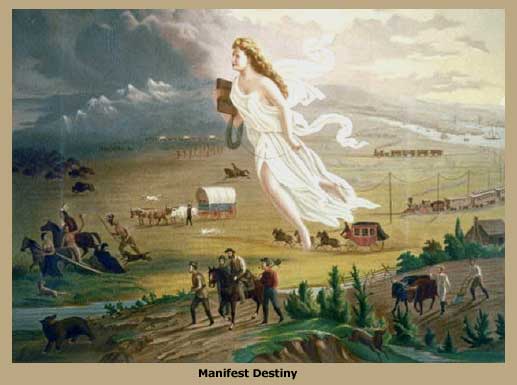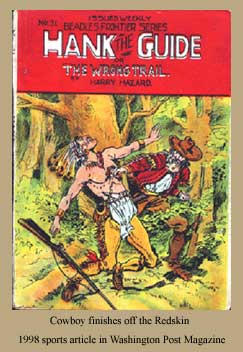 |

Basic Call to Consciousness

Intention

Invented White
History & Imagery

In the Beginning

First Nations Governance

Trail of Tears

Tragedy of
Little Bighorn

Massacre at
Wounded Knee

Duwamish/Suquamish
Displacement

Cultural Genocide

Native Values

Impact of European Immigrants

The Take-over

Called ‘Indian’ or....

Cultural Genocide - Boarding schools

Native Values &
Way of Life

Morality

Depression &
Substance abuse

Cultural Distinctions

Spiritual Sensibilities

Language

Living Two Lives

Leaders or Rulers

Written or Oral

Painful History

Iroquois Conservation

Chief Seattle’s
Farewell Speech

Spirit Road

|
 |

Invented White History & Imagery
The American civic distortion-myth is illustrated in our nation’s capitol rotunda. Visitors can view pictures of a developing America; First Nations People are depicted as wild savages blocking the progress of the Europeans as they conquer new territories. The most peaceful picture with an Indian theme in the rotunda shows the baptism of Pocahontas, daughter of the First Nation leader, Powhatan. Surrounded by Europeans and dressed in English clothing, she symbolically renounces the savage life of the Indians for the civilization of the British.

The image below is a dramatic and powerful allegory, a symbolic story that serves as a disguised representation for meanings other than those indicated on the surface. The characters in an allegory often have no individual personality, but are embodiments of moral qualities and other abstractions. Here we witness the representation of the Supreme & Superior attitude of the U.S. government, and, influencing the European immigrants, toward ‘their frontier’ and against the Indians.

A result of the so-called opening of the American West, 1860-1890 was an era of extraordinary greed, audacity, violence and astonishing sense of entitlement by the U.S. government and its new immigrant settlers in their lust for resources on a land already occupied by indigenous sovereign nations.

How is this immoral behavior able to occur by the civilized Europeans? The answer is found in the concept of manifest destiny. Policy-makers in Washington invented the term, in order to justify their breaking treaties with the Native Peoples and elevating greed for land and newly discovered natural resources to a lofty level. Manifest Destiny is a 19th-century belief that the so-called new country had a mission, therefore a right, to expand, spreading its form of democracy and freedom across what they considered uninhabited, wild land. Advocates of Manifest Destiny believed that expansion was not only good, but that it was obvious, “manifest”, and certain, “destiny”. Originally a political catch phrase of the 19th century, Manifest Destiny eventually became a standard historical term, often used as a synonym for the territorial expansion of the United States across North America towards the Pacific Ocean.

American Progress, depicted in the painting, above, by John Gast in 1872. George Crofutt, a promoter of American tourism, commissioned Gast to paint American Progress. This painting has also been called Westward the course of destiny, a symbolic portrayal of Manifest Destiny. It is allegorical of American expansion and offering a so-called moral rationalization for the otherwise immoral treatment of First Nations People--in particular, breaking land treaty agreements the government had promised to the Native People. Pictured here is the iconographic image of Columbia, the American angel floating above the land, leading her pioneers westward. The angel image--intended as a personification of the United States--floats ethereally over the plains, stringing telegraph wire with one hand as she travels, and holding a schoolbook under her other arm. Economic activities of the pioneers are depicted, especially the changing forms of transportation. Particularly poignant to the justification: ahead of her in the West is a great darkness populated by wild animals--bears, wolves, buffalo and Indian people--all considered wild and savage, and fleeing away from her light. In her bright-light wake, as the figure progresses across the land, come farms, villages and homesteads and in the back are cities and railroads. The light of so-called civilization dispels the darkness of so-called ignorance and barbarity. American Indian people are portrayed along with the wild animals as the darkness, all of which have to be removed before Columbia can bring the prosperity promised to the United States. The self-righteous attitude of the U.S. government and their lust for gold, other resources, and homesteading for the settlers, provided the moral belief justifying the destruction of a culture and civilization of people indigenous to the land who had lived and conserved resources here for thousands of years.

This painted image reflects a mind-set and belief of a nation perpetrated against a People--first occupants of the land.

During this period, as the culture and civilization of the First Nations was destroyed, the great myths of the American West were given birth--heroic cowboys fighting savage Indians, the dark threat to civilization; fur traders, gold-seekers, gamblers, gunmen, prostitutes, missionaries and homesteaders.  The pejorative Indian stereotype was born out of American myth and embedded into dominant-culture consciousness. The pejorative Indian stereotype was born out of American myth and embedded into dominant-culture consciousness.

The irony is that many of those romanticized men of the American myth were, in fact, more deserving of the insulting depictions reserved for the Indians due to these celebrated white men’s crude and savage behavior. The great American myths has its own self-serving purpose - how else does a young nation cope with their perpetration of genocide of a People who had lived on the land for centuries before the first invaders?

Another symbol of Manifest Destiny shows a railroad train coming out of the east with smoke billowing out of its boiler. It is moving west, bringing so-called technological enlightenment into the so-called wilderness. Americans in the 19th century and ever since, equating civilization with technological development, no matter what the cost, have devised effective rationalizations to rectify the morality of self-serving actions.

Expansion and Indian removal from their native areas created phenomenal problems for the new American government regarding its moral character. How can this unique experiment in the new world - this nation that prided itself upon its democratic institutions, force Native American people westward - off the land on which they had lived? How do you rationalize the taking of land and the forced removal of sovereign nations from their places of birth and sacred burial places of their ancestors?

The argument that was used was: This had to be done to save these poor Indian people. They don’t fit in the East, so we have to move them out beyond the frontier where they can do their Indian thing unmolested. This is the only possible way to save them. The hypocrisy of this is obvious as we come to know true historic facts. Many of the First Nations people who were removed were very sophisticated and actually behaved in a more civilized fashion than their white immigrant brethren who, as a group, systematically destroyed natural landscapes and drove native animals of the land into extinction. In fact, First Nations People were baffled by the settlers' destruction of the trees, the digging into land for gold, and wanton killing of animals. They believed the white people hated Nature!

Since the Europeans arrived in North America, Indigenous Peoples have lost millions of acres of land. First Nations people endured theft, murder and warfare, forced removal, deception, and official government land programs which have deprived them of their territories. Land rights of Native Americans were never taken seriously. Rather, they were seen as obstacles to the colonists’ need for land and desire for gold discovered throughout the West. The Puritans did not respect the farms of Native Americans; they sought “legal” ways to take the Native Peoples’ land from them.

Why does this matter now? one may ask... that was then--this is now. The answer: History has a way of intruding upon the present. William Faulkner stated: The Past isn’t dead--it isn’t even past. In the 21st century, we witness Manifest Destiny continuing in the righteous invading of other sovereign nations who had not attacked us, promulgating U.S. ideologies while inciting anger and rage in the people of these cultures against the United States. As citizens of this nation we must truthfully explore these repetitive historic patterns.
|
“If people are going to get back into balance, one of the things they have to do is seek the truth. They have to start really speaking the truth themselves, and that’s a difficult thing to do. The way it is now in the world, we don’t mind lying.” --John Peters (Slow Turtle), Wampanoag
|
First People have been stewards of Mother Earth long before European immigrants ‘discovered’ them. Their traditional ways of life was one of honoring and taking care of Her. Stories from oral histories have been passed down for generations of First People’s respectful attitude toward their natural resources as well as the Actual histories of First People and their leaders. It is important to realize from their stories that Earth is not something we can simply continue to take from--bulldozing a hillside, wiping out a forest, paving the earth for a shopping center. Their stories demonstrate a people whose needs were met by the Earth. They demonstrated respect in their hearts and minds toward their resources--both animal and plant--through ceremonies of gratitude and acts of conservation. Our planet is in need of this reverence-based consciousness, today.

Concern for the environment, today, is inexorably connected with traditional values of the First People. Perhaps these stories of actual accounts will inspire you as I have been inspired--to take action in some personal way to preserve our planet, to consume less, to pollute less, to consider the intrinsic values of First People and how these values may be implemented in our world, today and so, to restore health to our Mother Earth, therefore, preserving our wild life so their lives are not reduced to zoo existences.

In regards to historical trauma, the American myth hiding discrimination, racism, consumerism, corporate UNaccountability & greed. I note with disbelief - when hearing references to minority voting blocks in this country: African-Americans and Latinos--I am disturbed that never once are First People ever mentioned or included as part of the citizenry of our country! It’s as if the Native population does not exist in the consciousness of caucasian Americans!

It is my belief that as long as First People continue to be marginalized in this country, as long as we, as a nation, continue the denial of the genocide perpetrated against First People on this land -- we will be blocked from whole-heartedly embracing Respect and Healing for this land, our Environment and wildlife of which we, with our materialistic values, are destroying at an alarming rate. Lacking conscience, corporations, pull the strings, unfettered, on our legislature for their own self-serving greed. I am seeking some small way to encourage even a minute shift in consciousness toward action.
Click on the rug to return to the top of the page.

 Home Home
 Quiz Quiz
 About Author About Author


|
![]() ©2015 Lilthea Designs
©2015 Lilthea Designs